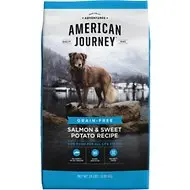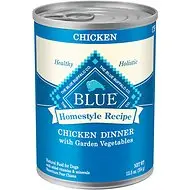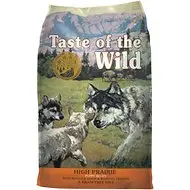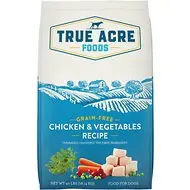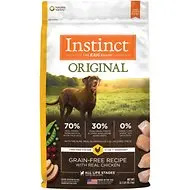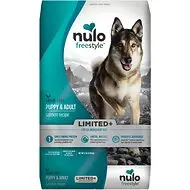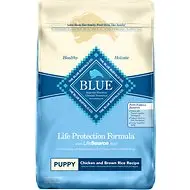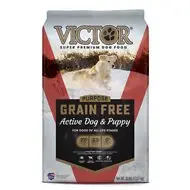11 Best (Highest Quality) Dog Foods for Bloodhounds in 2025
Quick Guide
- What is Best Bloodhound Dog Food?
- Key Nutritional Needs of a Bloodhounds Diet
- 6 Special Considerations for Bloodhounds
- Best Dog Food for Bloodhounds
- Taste of the Wild High Prairie
- American Journey Salmon & Sweet Potato Recipe Grain-Free Dry Dog Food
- Blue Buffalo Homestyle Recipe Chicken Dinner with Garden Vegetables & Brown Rice Canned Dog Food
- FirstMate Endurance/Puppy Pacific Ocean Fish Meal Formula Limited Ingredient Diet Grain-Free
- Taste of the Wild High Prairie Puppy
- 6 More Top Rated Dog Food For Bloodhounds:
- Our 2025 Bloodhound Feeding Guide
- FAQs:
- Conclusion
So, you’re at the pet store strolling down the dog food aisle. After the third pass up and down you’re still wondering what the difference is between the thirty various bags you’ve gone by, and you still can’t make a decision on which one will be best for your furry friend waiting patiently for his meal at home. Well, you’re in luck because you’ve stumbled on the key to making that decision. Based on your bloodhound’s age and your personal preferences, you’ll be able to choose from one of the foods we’ve reviewed below and save yourself from the endless pacing back and forth on ‘dog food aisle’ the next time you go to the pet shop.
As you may already know, or will soon be privy to if you’re thinking of getting one, the bloodhound is a large breed that grows up to 110 pounds (American Kennel Club, 2025). Known for their exceptional sense of smell, bloodhounds often enjoy long walks where they can utilize their exceptional sense of smell to sniff anything interesting the wind may carry their way. In addition to a firm grip, owners will need to provide high-end sustenance for this keen-sensed canine. Depending on your budget, feeding philosophy and dog’s age, there are a number of great options to choose from. That’s where we come in.
What is Best Bloodhound Dog Food?
- Taste of the Wild High Prairie
- American Journey Salmon & Sweet Potato Recipe Grain-Free Dry Dog Food – Most Affordable
- Blue Buffalo Homestyle Recipe Chicken Dinner with Garden Vegetables & Brown Rice Canned Dog Food
- FirstMate Endurance/Puppy Pacific Ocean Fish Meal Formula Limited Ingredient Diet Grain-Free
- Taste of the Wild High Prairie Puppy
- True Acre Foods Chicken & Vegetable
- Instinct by Nature’s Variety w/ Real Chicken
- Nulo Freestyle Limited+ Salmon Recipe Grain-Free Puppy & Adult Dry
- Farmina Natural & Delicious
- Blue Buffalo Life Protection Formula Puppy Chicken & Brown Rice Recipe Dry
- Victor Active Dog & Puppy
Key Nutritional Needs of a Bloodhounds Diet
- Protein-rich foods to support active muscle use
- Animal-based fats to support bloodhound’s high energy, immune & coat health (Dog Food Insider, 2015)
- Complex carbs containing dietary fiber
- Probiotics for smooth digestion
- Plenty of water
6 Special Considerations for Bloodhounds
- At home, they’re reasonably calm and collected. On walks, however, they follow their exceptional noses and can be highly active so they tend to eat a lot in turn.
- Being a larger breed, bloodhounds are prone to bloating. This potentially fatal issue can be combated by feeding your bloodhound frequent smaller meals (three to four) throughout the day instead of one or two large meals. Snacks in between meals have also been shown to reduce the risk of bloating (Cooper, 2016).
- Bloodhounds tend to have drooping ears and snouts, making it easy for food to get trapped. Be sure to wipe your hound’s face and ears after meals to avoid bacterial infections.
- Due to their drooping snouts, bloodhounds don’t retain saliva very well. Let’s just say it rains a little bit when these hounds shake their heads. In addition to wiping your hound’s snout, it’s best to have them eat outside to avoid a post-food-fight scene in your home after meals.
- Training your bloodhound is essential to a healthy relationship with this large, active breed. Using a scoop of food and only feeding your hound one kernel at a time will establish you as the pack leader. This is a great way to get your dog to begin following your lead.
- Bloodhounds have been known to develop certain food allergies. Be sure to monitor your dog’s health during and after feeding and consult a vet if you notice reactions to food (Barrington, 2015).
Best Dog Food for Bloodhounds
| Our 2025 Picks: Best Dog Food for Bloodhounds | |||
Taste Of The Wild High Prairie
|
CHECK PRICE | ||
American Journey Salmon & Sweet Potato Recipe Grain-Free
|
CHECK PRICE | ||
Blue Buffalo Homestyle Recipe Chicken Dinner
|
CHECK PRICE | ||
FirstMate Endurance/Puppy Pacific Ocean Fish Meal Formula
|
CHECK PRICE | ||
Taste Of The Wild High Prairie Puppy
|
CHECK PRICE | ||
True Acre Foods Chicken & Vegetable Recipe
|
CHECK PRICE | ||
Instinct By Nature’s Variety W/ Real Chicken
|
CHECK PRICE | ||
Nulo Freestyle Limited+ Salmon Recipe Grain-Free Puppy
|
CHECK PRICE | ||
Farmina Natural & Delicious
|
CHECK PRICE | ||
Blue Buffalo Life Protection Formula Puppy Chicken
|
CHECK PRICE | ||
Victor Active Dog & Puppy
|
CHECK PRICE | ||
Taste of the Wild High Prairie
Key Features:
- Dry
- Adult Stage
- Grain Free
- Protein Heavy
- Probiotic
Overall Best Dog Food for Bloodhounds – The top all-rounder on our list gets its rank based on an exceptionally well-rounded blend of nutrients, ease of digestion & reasonable price-point. This top-tier dry food is intended for adult dogs and comes in a 5-lb, 14-lb or 28-lb bag.
Taste of the Wild has created a blend that aims to stay true to a dog’s historically natural diet of raw meat. As such, the High Prairie mix is composed of real buffalo, bison & venison meat in addition to real fruits & vegetables. Additionally, this feast is paired with probiotics to support your dog’s digestive process. This one exceptionally good for fast-growing bloodhounds that need the extra protein to support healthy muscle-tissue development.
While we can never guarantee this will be your dog’s favorite given all dogs are created unique, a majority of canines love this blend despite being picky eaters. Being in such high demand, this food also sports a very reasonable price point just landing in the lower third of our list cost-wise. A great choice for those who want everything packed into one.
Pros:
- Reasonable Price
- High Protein
- Nutrient Rich
- Probiotics
- Desirable Flavor
- Grain-Free
Cons:
- Wild Game Smell May Bother Owners
American Journey Salmon & Sweet Potato Recipe Grain-Free Dry Dog Food
Key Features:
- Dry
- 2-for-1 Deal
- All Life Stages
- Grain Free
- Lean Protein
- High Fiber
The American Journey Salmon & Sweet Potato blend clocks in as our favorite pick at the best price. Owners get to buy two bags for the price of one as a one-time deal with this option. That’s an exceedingly great deal considering what you’re getting. This option is available in a 4-lb, 12-lb or 24-lb bag.
Our pick is made with real salmon, giving your dog plenty of lean protein to support muscle growth without packing on pounds of fat. Salmon oil has also been shown to support coat health. If your dog likes the taste of fish, this is a surefire way to spoil him or her. The blend also contains sweet potato carbohydrates, so dogs won’t leave the dinner table with empty stomachs. To support digestion and boost energy American Journey comes with chickpeas for a fiber source. To top it off, this food can be used for all stages of your dog’s life, although as an owner you want to make sure your dog’s specific nutritional needs are met particularly when it comes to calories.
The one downside comes with the fish flavor. While some dogs may love it, others may despise it. Give your dog a tester before investing to make sure you don’t buy the wrong fit for your bloodhound’s sensitive nose.
Pros:
- Inexpensive w/ Promotion
- All Life Stages
- Grain Free
- Fiber Source
- Lean Protein Source
- Fish Oil
Cons:
- Fish Smell May Throw off Some Dogs
Blue Buffalo Homestyle Recipe Chicken Dinner with Garden Vegetables & Brown Rice Canned Dog Food
Key Features:
- Wet & Canned
- Includes Whole Grains
- Vegetables, Brown Rice, Chicken
The Best in a Can – For the dogs that need a little bit extra when it comes to flavor, Blue Buffalo may be just what the doctor ordered. Packed with flavor from chicken broth & liver this blend is sure to be sniffed out by your hound from the opposite end of the house. While canned food is generally more expensive than dry food, it can be a remedy for dogs who lack an appetite for any dry foods.
This option, unlike many of the others, comes with whole grains like rice and barley. While some may prefer to feed their dog a grain-free diet, grains have been shown to reduce a dog’s energy levels due to the higher digestion demands grain comes with. This may be an advantage if you have an exceptionally high energy dog. Conversely, grains can upset a dog’s stomach because they are more difficult to digest. It is worth mentioning that Blue Buffalo is made without wheat however, unlike many other canned dog foods that use wheat as a thickening agent. That makes this canned option better for those concerned with introducing grains to their dog’s diet.
Overall, this is a great option for owners in search of a more flavorful dish for their canine. Orders come in a case of 12 cans.
Pros:
- More Flavorful Than Dry Food
- Includes Real Chicken Meat & Vegetables
Cons:
- Grains
- Higher Price
FirstMate Endurance/Puppy Pacific Ocean Fish Meal Formula Limited Ingredient Diet Grain-Free
Key Features:
- Dry
- Puppy Stage
- Hypoallergenic Formula
- Grain Free
- Fish
The Best with Limited Ingredients – First Mate’s puppy formula is designed specifically for puppies with allergies to ingredients commonly found in other mainstream dog foods. That makes this an ideal choice if your hound has shown allergic symptoms after eating ingredients like chicken, beef or vegetables. This blend is made with herring and potatoes, providing sources of protein and carbohydrates from an exceptionally limited number of ingredients.
While it may seem that a limited number of ingredients equates to less nutritional value, this food still packs a punch with nearly 3500 kcals per cup. That’s the same or more than plenty of other dog foods on the market that don’t sport the ‘limited ingredient’ badge. Limited ingredient food can also lead to better digestion and energy levels for dogs.
All that being said, before deciding whether or not to use a limited ingredient dog food it’s wise to consult a vet. If you’re concerned your pup has allergies get a test done to determine what, if anything, he or she is allergic to. It may be wiser to stick with a standard type of dog food depending on your dog’s situation. The food is considerably more expensive than others on our list, so educating yourself prior to purchase is recommended. Options are either a 5-lb, 14.5-lb or 28.6-lb bag.
Pros:
- Single Source of Protein & Carbs to Combat Allergies
- Grain Free
Cons:
- Expensive
Taste of the Wild High Prairie Puppy
Key Features:
- Dry
- Puppy Stage
- Grain Free
- Protein Heavy
- Probiotics
The Best for Puppies – Here is the little brother of our top pick, specially designed for dogs in the puppy stage of development. Like its older sibling, the Taste of the Wild puppy blend is rich in protein from buffalo, bison and venison sources. This makes it ideal for supporting fast-growing bloodhound pups with rapidly developing muscle tissue. The included probiotics make it easily digestible, so puppies with more sensitive stomachs can chow down without feeling sick. The blend is also grain free, so owners aiming to nurture their dogs with this diet can start them off young.
As with the adult version, the Taste of the Wild puppy mixture is very reasonably priced compared to the competition. The only drawback is the intense gamey odor the food comes with. As long as that isn’t a deal breaker for your pup this is a fantastic option for young, growing bloodhounds. The bags are available as a 5-lb, 14-lb or 28-lb option.
Pros:
- Grain Free
- Protein Supports Young Dog’s Muscle Development
- Probiotics for Digestion
- Reasonable Price
Cons:
- Intense Game Oder
6 More Top Rated Dog Food For Bloodhounds:
True Acre Foods Chicken & Vegetable
Key Features:
- Dry, Adult Stage
- 2-for-1
- Grain Free
- Chicken-Based
This adult blend is probably the best grain-free adult food for its price-point. Not only is a single purchase very reasonably priced but owners can get a one-time two for one deal when they chose this option in a 15-lb, 30-lb or 40-lb bag.
Budget aside, the food is entirely grain free and packed with the nutrients your adult bloodhound needs to sustain a healthy lifestyle. Protein comes from a lean-sourced chicken and is supported by farm-grown veggies.
The upside with this pick is that it’s specialized for adults, supporting an active exercise schedule and healthy digestion with antioxidants and fibers. Definitely the most bang for your buck if you’re shopping for an adult bloodhound on a budget and don’t want to sacrifice quality.
Pros:
- Great Price
- Grain Free
- Lean Protein
- Fibers & Antioxidants
Cons:
- Dogs Might Get Bored of Basic Flavor
Instinct by Nature’s Variety w/ Real Chicken
Key Features:
- Dry
- Adult Stage
- Cage-Free Chicken
- Grain Free
- Probiotics
If you prefer shopping in the organic section of the supermarket, this one is for you. Instinct by Nature’s adult blend sports a prestigious ‘cage-free’ label, referring to how the food’s chicken is sourced. At a surprisingly good price, your dog gets a guaranteed healthy dose of lean protein with this meal.
Not only is the chicken free-range, but the kernels are grain-free and infused with probiotics to ensure smooth digestion. Not to mention, a cup of this stuff packs a whopping 4,700 kcals. That’s more than any other food on our list and is sure to not leave you bloodhound wanting. Whoever said eating healthy wasn’t as tasty?
Ironically this may not be the best option if you need your dog to lose weight given its high caloric count. Conversely, it’s a great choice if you want your dog to put on a few pounds or if you two lead an exceptionally active lifestyle together. The bags are available in 4-lb, 11-lb or 22.5-lb doses.
Pros:
- Good Price
- Free Range Protein Source
- Grain Free
- Filling
- Probiotics
Cons:
- High-Calorie Count Not Ideal for Overweight Dogs
Nulo Freestyle Limited+ Salmon Recipe Grain-Free Puppy & Adult Dry
Key Features:
- Dry
- Adult & Puppy
- Limited Ingredients
- Low Carb
- Salmon-Based
- Probiotics
- Fiber
- Grain Free
Sometimes we don’t settle for anything but the very best for our prince or princess. Nulo Freestyle sure doesn’t expect you to with this high-end salmon-based blend of delight. This food is intended for dogs with allergies to things like chicken and vegetables. Its protein is entirely derived from salmon, and it contains limited carbs to ensure your hound doesn’t pack on too many pounds while devouring all the delicious fish.
To ensure a smooth digestive process this pick is packed with probiotics as well as fiber from chickpeas. In case that still isn’t enough, it’s entirely grain free. If your dog has any allergies or needs to be put on a limited-ingredient diet you really couldn’t be spoiling him or her any more than this.
The one drawback, as with any luxury item, is its high price-point. But if you don’t mind shelling out a few extra bucks, your dog would thank you repeatedly if dogs could talk. That is, assuming he or she likes fish.
Bags come in 4-lb, 10-lb or 22-lb quantities.
Pros:
- Grain Free
- Single-Sourced Protein
- Low Carbs for Weight Watching
- Probiotics
- Fiber
- Suitable for Puppies & Adults
Cons:
- Low Carb May Not Suit Underweight Dogs
Farmina Natural & Delicious
Key Features:
- Dry
- Puppy Stage
- High Protein
- Low Carb
- Low Fiber
- Low Grain
This one is for puppies that need a little extra help along the growth path. Farmina’s blend is packed with protein but sports a low carb-count, making it ideal for dogs that need to build muscle without becoming overweight from eating too much. The food isn’t grain free, but it contains very little in case you want to keep some grains in your dog’s diet without going overboard on the grain-scale.
For a dry food, this blend is shown to pack some serious flavor with dogs following their owners around the house begging for more. It does come in a little pricey compared to competing foods, but giving your dog the protein-boost may be worth the cost.
The only size option for this one is a 26.4-lb bag, so make sure your pup is hungry!
Pros:
- Extra Protein
- Low Carb
- Full Flavor
- Low Grain
Cons:
- One Bag Size
Blue Buffalo Life Protection Formula Puppy Chicken & Brown Rice Recipe Dry
Key Features:
- Dry
- Puppy Stage
- High Antioxidants
- Calcium
‘Life Protection’ isn’t just a branding ploy, Blue Buffalo sports the ingredients that support that tagline. This blend was put together specifically to ensure puppy dogs grow up healthy.
One key differentiator from other puppy foods is a higher antioxidant count as well as a calcium boost. These are responsible for developing a healthy immune system and solid bone structure, respectively. Then there’s a lean protein sourced from chicken to support muscle growth. This blend isn’t grain free like many others, but it does lack corn & wheat so it’s still on the lower spectrum for those looking to limit their pup’s grain-intake.
Available at a reasonable price, this is a solid choice for a non-allergic and otherwise healthy, growing puppy. The bags come in 3-lb, 6-lb, 15-lb or 30-lb options.
Pros:
- Calcium
- Antioxidants, Low Grain, Lean Protein, Wide Bag-Size Spectrum
Cons:
- Chicken Flavor May Get Boring for Some Dogs
Victor Active Dog & Puppy
Key Features:
- Dry
- Grain Free
- Adult & Puppy Stage
- Hypoallergenic
Containing protein from virtually everything but chicken this blend is designed for growing puppies and active adults. It goes without saying that this option will suit dogs with allergies to chicken. The added benefit of its multi-sourced proteins is a versatile flavor that may suit more dogs’ pallets. On top of it all, the blend is grain free for those looking to keep that out of their dog’s diet.
The food sits just about in the middle of our price-bracket, and is a good choice for dogs allergic to chicken that don’t like fish!
Bags are available in 5-lb, 15-lb or 30-lb sizes.
Pros:
- No Chicken
- No Grain
- Suitable for Puppies & Adults
- Versatile Flavor Option for Fish-Haters
Cons:
- Lack of Digestive Supplements
Our 2025 Bloodhound Feeding Guide
Bloodhound Puppies – Calling bloodhound puppies rambunctious balls of energy would be the understatement of the year. Needless to say, they eat a lot and require plenty of nutrition. Puppies range from birth up until about one year of age. As you can imagine, massive development takes place during this first year with the most growth occurring between 4 months and 8 months (Cooper, 2016). Most will agree that you should keep feeding your puppy the same food until it nears maturity, in the case of the bloodhound until about 10 to 12 months of age.
When it comes to how much to feed your bloodhound puppy, let’s take a quick look at average weight during this stage of your hound’s development. Bear in mind that these are estimates, and you should frequently weigh your puppy to determine how quickly he/she is growing. Additionally, females weigh about 10 lbs. less than males on average (DogTime, 2025).
- At 3 Months: 25 to 35 lbs.
- At 6 Months: 55 to 80 lbs.
- At 9 Months: 70 to 90 lbs.
- At 12 Months: 80 to 100 lbs.
Given these weights, let’s look at how much food it takes to achieve them. One thing to note is that you’ll want to feed your puppy a large-breed growth food to regulate the speed at which he or she grows. This prevents problems like hip dysplasia when they reach maturity (VCA, 2025). Again, these are estimates and every dog is different so keep track of how much your hound is eating and consult a vet if you’re concerned with a lack of appetite or overeating.
- 0-3 Months: 4-6 Meals Daily Totaling 600-800 Calories
- 3-6 Months: 4-6 Meals Daily Totaling 900-1300 Calories
- At 9 Months: 3-4 Meals Daily Totaling 1400-1700 Calories
- At 12 Months: 3-4 meals Daily Totaling 1700-2000 Calories
Bloodhound Adults – Adult females will grow up to 100 lbs. while adult males can grow up to 110 lbs. When your bloodhound reaches maturity, typically between 12 and 16 months of age, it’s time to start looking at adult dog food that contains fewer nutrients like fat and protein per calorie. Since adults don’t grow like puppies do they don’t need food as rich as puppy food (Purina, 2025).
To give you an idea of an adult bloodhound’s food intake, active adults weighing 90 pounds eat around 2000 calories daily (Cooper, 2016). Keep in mind that bloodhounds are exceptionally prone to bloat. Therefore, feeding them several smaller meals per day is highly advisable to reduce risk. Other than that, the food you choose is a question of personal preference, both yours and your dogs of course.
Bloodhound Seniors – At around age 7 or 8, bloodhounds are considered to be seniors by most vets. This change can be a bit tricky. Senior dog foods are often less caloric than normal dog food because they assume older dogs are overweight (Cooper, 2016). Don’t worry, we won’t assume you’ve raised your dog to be pudgy. However, we will urge you to pay close attention to your dog’s weight before concluding a switch to a senior dog food is necessary. If your male bloodhound is well over 110 lbs. or your female bloodhound is over 100 lbs. it may be wise to make the switch. If not, stick with what you’ve been using.
It’s also possible that older bloodhounds will start to develop digestive problems. This will become apparent if your dog begins to lose weight and muscle tone. As such, switching to a food that is easier to digest may be wise (Cooper, 2016).
All that being said, senior bloodhounds should still have quite an appetite. Keep feeding your hound as you did during the adult years and if you notice any drastic changes such as weight loss or loss of appetite consult your vet.
FAQs:
- Should a Bloodhound eat dry or canned food? Either one is fine. Some say that combining wet and dry food reduces the risk of bloating, but providing three or more dry meals throughout the day should work for that as well. If you notice that your bloodhound isn’t finishing his or her dry meals, it may be smart to mix in some wet food to enhance the smell & flavor of the food. Long story short, it’s a matter of preference.
- Should my Bloodhound eat a grain free diet? It really depends on your dog. A grain-free diet more closely resembles the historical diet of wild dogs, meats from hunted game. It’s true that grains can be more difficult for your dog to digest and as such it’s up to you as the owner to pay attention to your dog’s digestive activity. If you are using food containing grain and noticing your dog is having trouble digesting, you may want to consult a vet and ask if switching to a grain-free diet would be beneficial.
- Do Bloodhounds have sensitive stomachs? Not particularly compared to other dogs. In general, dogs of any breed can have temperamental stomachs depending on what they’re eating off the floor, health issues, stress and a handful of other factors. The important thing for owners is to pay attention to their dog’s digestion. If your hound is frequently vomiting, having diarrhea or not eating it’s a good idea to visit the vet to find out what’s causing problems. Bloodhounds are exceptionally prone to bloating, however. This should be avoided at all costs, as bloating can be fatal for a dog. Feed your hound multiple smaller meals throughout the day instead of one or two large meals. Between 3 and 6 is a safe number and should do well in preventing bloat.
- Why does my Bloodhound fart so much? Dogs pass gas just like humans do, as a normal part of the digestive process. However, there are a few cases where medical attention may be required for your hound. If you notice that gas coming from your pet smells unusually foul or is causing discomfort, you may want to see a vet. Your dog may have an infection or a condition like inflammatory bowel disease (Wag!, 2025).
- Is a Bloodhound considered a large breed? Yes, bloodhounds are considered to be a large breed. The male can grow up to 110 lbs. and the female can grow up to 100 lbs. That being said, these are very gentle giants and are used to the company of humans.
Conclusion
You may not be hungry after reading our review, but your dog probably is because let’s face it, they’re always hungry. Keep in mind through all this that not all dogs are created equal and situations can be drastically different from one bloodhound to the next. While we’ve provided recommendations, it’s always up to the owner to identify what his or her dog likes and dislikes. When it comes to food, dogs can be finicky and picky. What works one day may not work the next. It’s a good idea to experiment with different flavors and types of food to determine what the best fit is for your bloodhound, and not to be discouraged if he or she just won’t eat! A visit to the vet is always a safe bet if you think something is off. Otherwise, best of luck in choosing your hound’s next meal and don’t forget to wipe that face after breakfast, lunch and dinner!



